We can let you know when we update our list with more treatments
The Treatment Plan lays the foundation for any major oral rehabilitation. It is the essence that will make your endeavor fail or succeed. What follow are simple descriptions of few treatments that may compose your Treatment Plan.
This list will continue to be populated as we grow, so please do not hesitate to send your requests
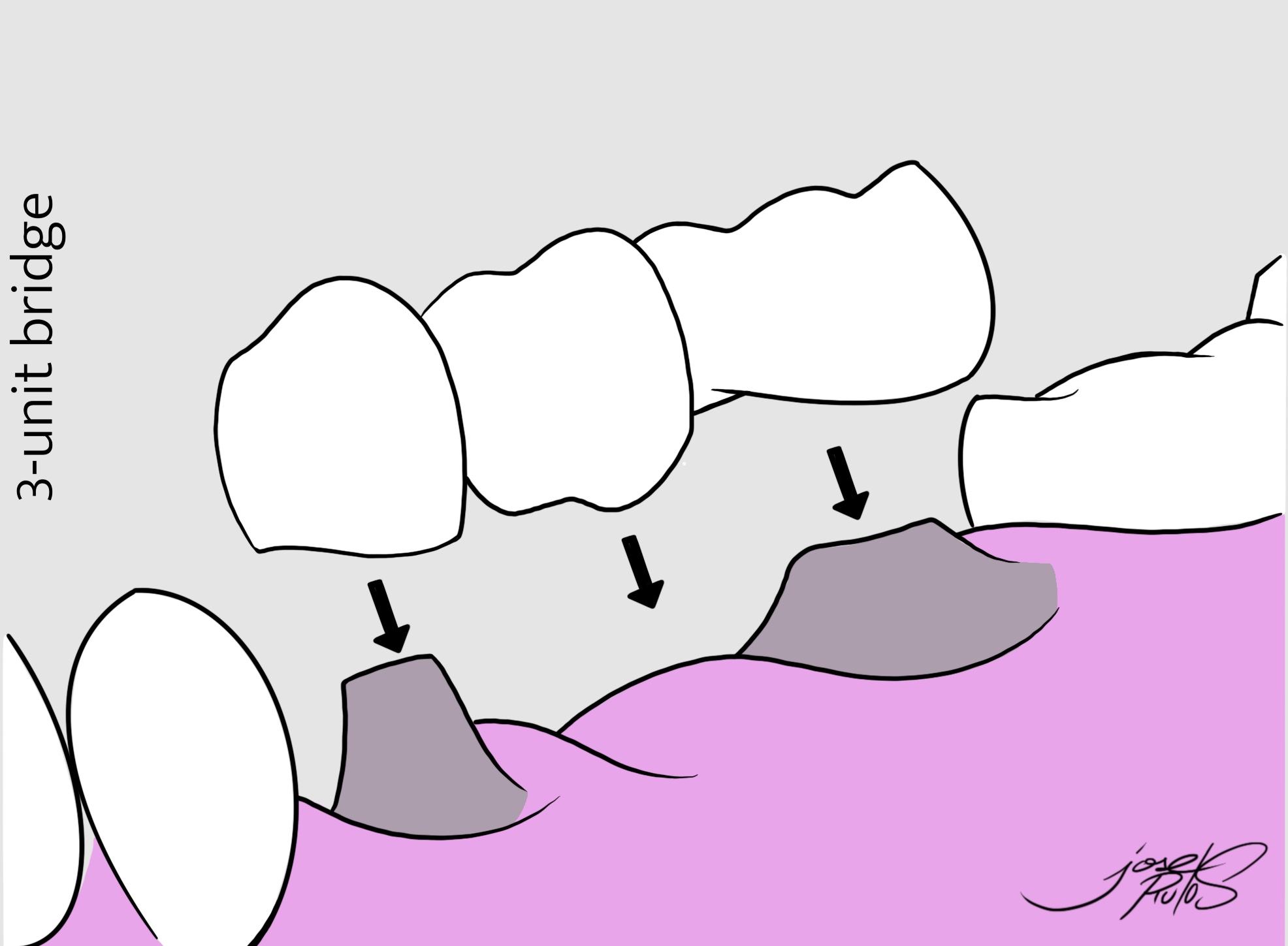
Crown & Bridge
A crown is a prosthetic reconstruction that covers a tooth. It can serve one of two purposes. First, reinforcing a weakened tooth, usually after a root canal. -I remind you that if there is no root canal, the treatment of choice is an onlay-. Know that a premolar or molar that has a root canal should always immediately get a crown. If you wait, you will lose the tooth.
Crowns can also sit on a living tooth when it is used as part of a bridge. A bridge is made to replace one or more missing teeth using remaining natural teeth as support. It is the alternative to implant(s), and vice-versa. When a bridge is made over vital teeth – teeth that still have the nerve in them- some technical difficulties arise for the practitioner, to not cause irreversible damage to the pulp -nerve-. There is a chance that the tooth could still require endodontic treatment later. It is one of the reasons why Implants can be a better option.
Crowns and bridges can be made from metal-ceramic or zirconia ceramic. A metal-ceramic bridge or crown doesn’t imply that metal will be visible. It will require a more skilled ceramist – Lab Tech-. Made, over precious metal, it is still today the treatment of choice, in my opinion, as metal gives a better seal at the margins. Most reconstructions are nevertheless made with zirconia since the digital era has brought by machines that mill zirconia. Often, at least for single crowns, the Dentist may have the milling machine in-house, and make your crown on the go. This will be valid for posterior teeth as the naturalness and transparency of a beautiful front tooth will imply and artist-ceramist, to build the aesthetic layer on top of the zirconia.
Dentures
Acrylic partial dentures
We are in 2020, please don’t take an acrylic removable partial denture home as a final restoration unless you have no means for living. It is not a final option; you will lose your remaining teeth and end up very soon with a full denture! Acrylic partial dentures are temporary appliances.
Metal framed partial dentures
This is the right option if you must wear a removable denture because of financial issues or lack of bone for implant placement. Your remaining teeth have to be appropriately restored and prepared for the denture, and in the right hands, this will give you comfort and a durable solution.
Full Denture
This option is the one when you have no teeth left, and no money or no bone for implants. It is removable and will give you good aesthetics and better comfort for the upper than the lower jaw. It should be removed at night and revised by a dentist or denturologist once a year – depending on what is legal in your country- As you keep losing bone, it should be refilled so that it adjusts accurately and remains stable. In that way, you will reduce bone loss. If you can wear implants, there are different options for combining them with dentures that can give you a much better quality of life. Please refer to our implant guide for more details
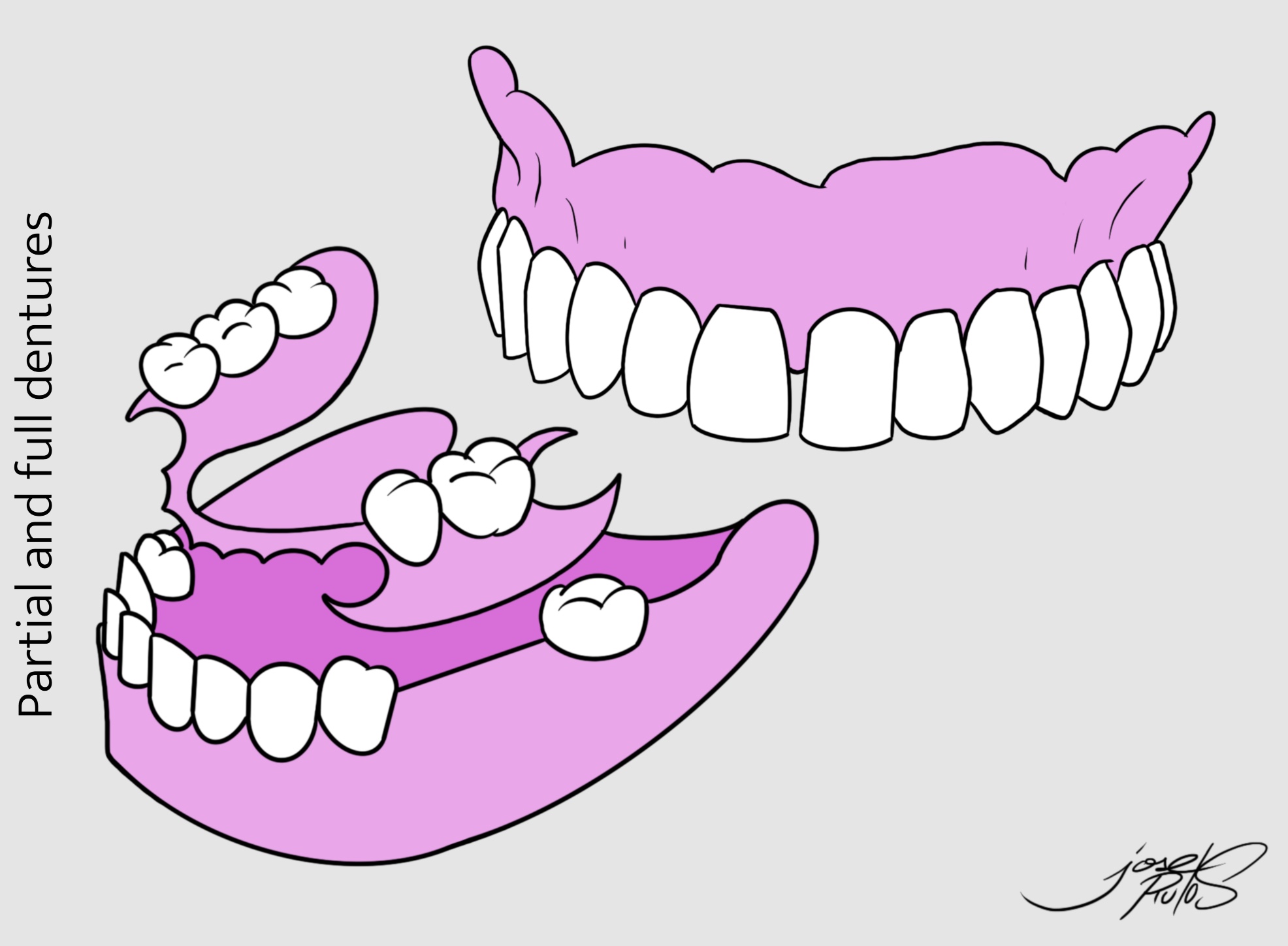
Fillings
A filling is the most conservative dental restoration. It is done when a decay/cavity is present on a tooth. It is made by the dentist in one go, with composite-resin (white), or amalgam (grey). Despite the long span crusade against amalgam fillings initiated in 1841 by the American Society of Dental Surgeons and perpetuated by the World Health Organization -WHO-, amalgam fillings are the most durable and resistant material that has been made to this date. The U.S. FDA, the World Dental Federation, Mayo Clinic, the American Cancer Society, the American Academy of toxicology, the environmental Protection Agency, and even WHO had to acknowledge that amalgam fillings lasted longer than any other material, and presented no risk for Patients health. Now WHO is still promoting the phase-down of Dental amalgam in developing countries, which, are the ones that can least afford treatment failure. This time, they use the excuse of environmental consequences in underdeveloped countries. Really? For what volume of fillings? Oh yes, and the effects of cremating bodies with amalgam. Wow. Some people must be really bored, or 3M -the first manufacturer of dental composites, must be a significant donor of WHO.
As a Patient, I have amalgam fillings. Most Dentists will stay away from composite materials for themselves. The main reason for this being that resins shrink as they set, thus, leaving a gap for bacteria to grow from the moment they are made. It is essential to know that any tooth that is restored will always be at a higher risk of getting decayed than a healthy tooth no matter the material due to the contact surface area between the tooth and the restoration. Consider that there are even areas we seal manually with no visual access; This becomes more critical with composites. Why do we do them? Because of Patients’ demand for aesthetics. When Lady Gaga sings, it makes sense. When you sing under the shower, it doesn’t. Then what? The best alternative to an amalgam filling is a porcelain Onlay-see below-. If you want aesthetics, pay for it. If you can’t afford to get an onlay, then settle for an amalgam filling that will last and an average of fifteen years.
Gingivectomy
A gingivectomy is a procedure performed in the gum to improve the aesthetic result of an anterior restoration or to gain access to healthy tooth structure to save a deeply decayed tooth. To put it bluntly, we cut the gum to give a new contour. In a practice aesthetically oriented, as we have seen in Chapter 5, it will often be combined with Veneers or anterior crowns. Anterior implant cases may also require it as the gum level on implants is not easily predictable but can always be corrected. The best tool for gingivectomies as far as a result and post-operative comfort, is a soft tissue laser, nowadays present in most practices. You can make sure they have it.
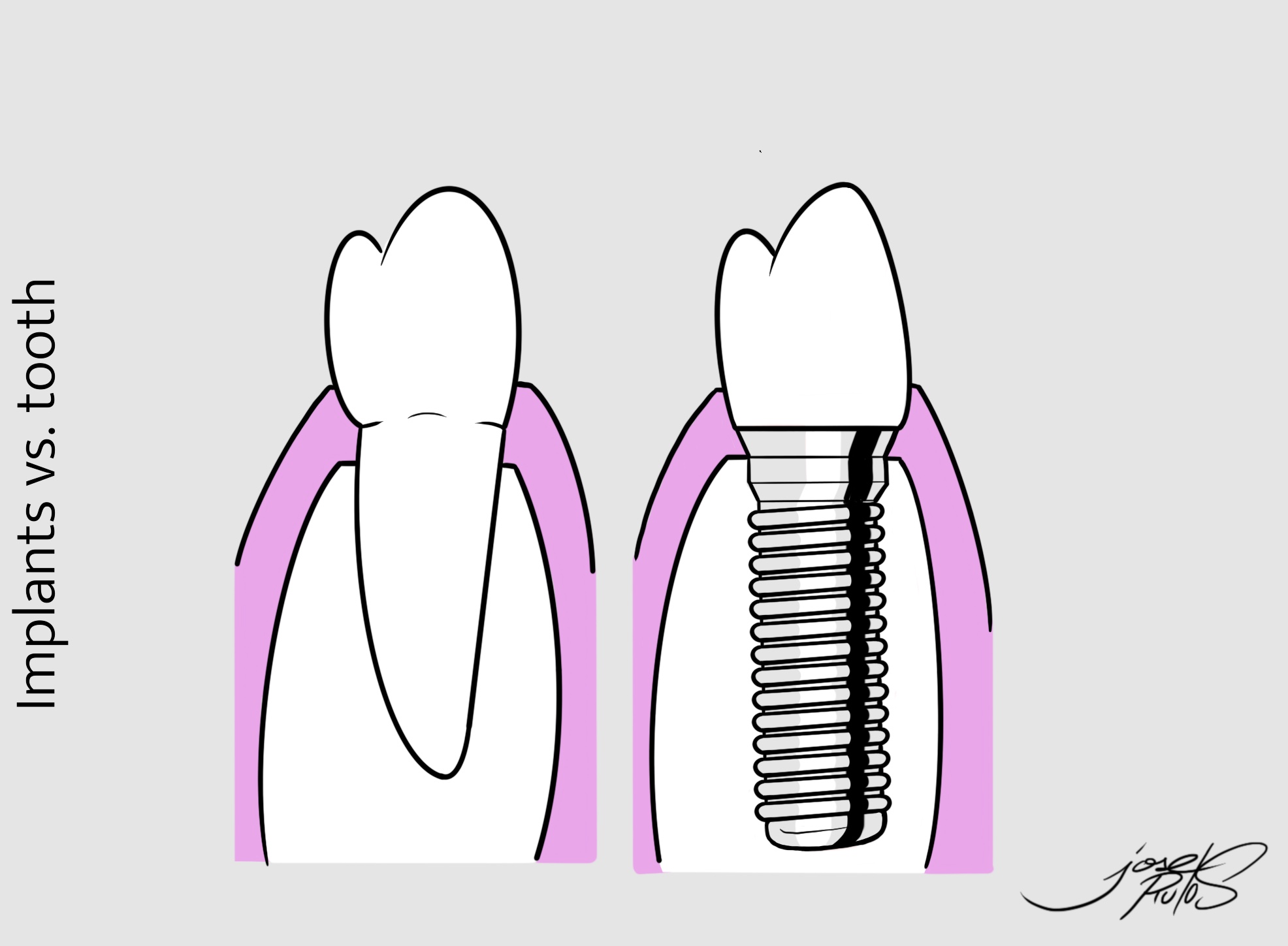
Implants and bone grafting
Dental implants are titanium fixtures we insert inside the bone to mimic the role your original root was playing. A natural tooth that is pulled out has the outside part you see, which we can call the clinical crown, and the root -can be one or multiple-which is inside the jaw, surrounded by bone. When a tooth is extracted, we remove it all. An implant is a screw-like element that replaces the root, and then, a crown will be made to replace the clinical crown. So, a tooth can be replaced with a bridge or an implant. A bridge implies in most cases damage to healthy teeth, whereas implants are stand-alone units, that don’t require the support of healthy teeth. For that matter, implants and teeth should never be connected.
Immediate implants
We call immediate implants the ones placed at the time of extraction. Many dentists perform them a lot, but they are a double-edge sword. Make sure you are the one in a hurry, not the Dentist, and make sure you understand the repercussions if it fails. It requires highly skilled and experienced surgeons to place immediate implants successfully. Make sure you ask for pros, cons, and you make an informed decision.
Delayed implants
They are the most common. Usually, the pulling of the tooth and the implant placement are at least eight to twelve weeks apart. This allows for the bone to fill the gap left by the extraction, and the implant to be placed in the best conditions, in healthy bone. Waiting more time is not a problem, though waiting too much -above one year-, can cause bone loss. What allows for the bone in your jaws to be maintained, is the stimulation generated initially by your dental root, and later, by our dental implant. In the absence of a structure inside the bone, you will lose volume irreversibly. Therefore, I said before that if you wait for too long to have the money, you will not have any bone left, and will need a bone graft!
Bone grafting
As I said, bone grafting may be needed when you have lost bone, either due to disease, the extraction itself, or time. The most efficient bone grafts for volume will be autologous, meaning that we need your bone taken from somewhere else to recover the required anatomy. We can find donor sites inside your mouth, around the knee, the hip, or the skull.
Sinus elevations are a specific type of bone graft sometimes needed to place implants in the molar region, based on your anatomy. In the right hands, they have a low rate of complications. Sinus elevations do not require autologous bone unless they need a large amount of grafting. There will be a specific guide for dental implants and bone grafts shortly since there is too much information to share here.
Nightguards
Nightguards are usually transparent, acrylic-based appliances worn on one arch alone. Patients wear them at night, to protect their natural teeth or the restorative work achieved during dental treatment. If they are made tight, they also play an essential role in stopping teeth from further movement. In this case, they are used after orthodontic treatment to maintain the attained result. An option is also to wear them to prevent more chaos when teeth are already somehow crooked. There are two types of guards. The most frequent is thick full arch nightguard made of soft material that in my opinion, pushes you to be chewing all night and can cause muscle discomfort. The second, less frequently used due to training, is the one developed by Dr. Gene McCoy. It is rigid, usually 1.5mm thick, and as a general rule, -this being intended for Dentists – will go from canine to canine, as long as the bite is normal and canines are healthy. By decreasing contacts on posterior teeth, the forces developed at night are lessened, thus allowing for muscle relaxation, and stopping overstimulation of the chewing muscles at night. Innumerable Patients have thanked me and praised the latter model once I started delivering those. It is also the one I have used for over twenty years. As a grinder, having broken teeth and having had severe TMJ – temporomandibular joint- issues, I cannot recommend enough this type of nightguard.
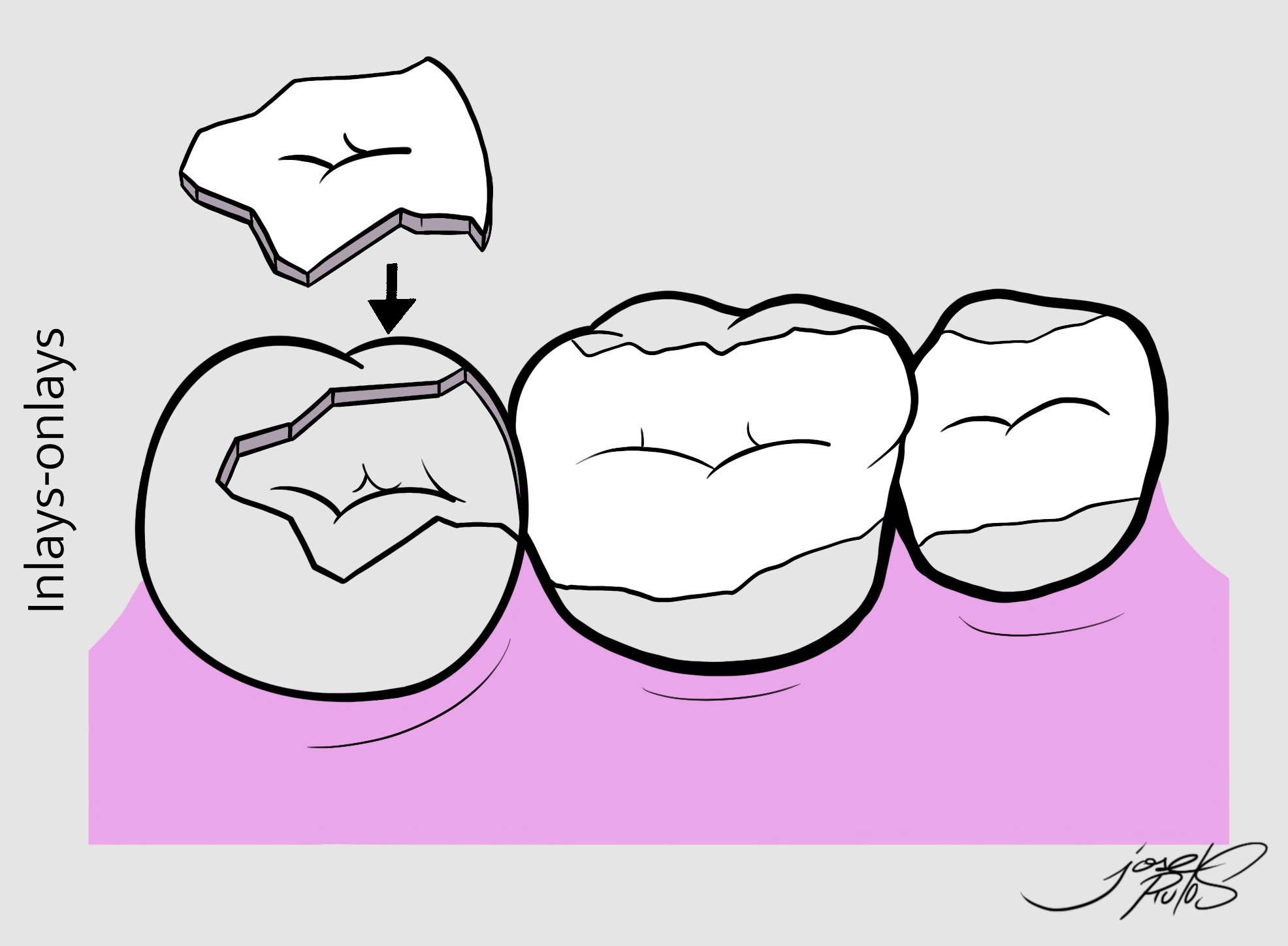
Onlays
An onlay or inlay–they differ in shape- is a gold or porcelain filling-like restoration made by the dental lab. It is better than a filling for this exact reason. As it is made by the lab on a stone model made from a silicone or digital impression, all margins are accessible to the eye of the Lab Tech. The precision is much higher, thus guaranteeing a better prognosis. Yes, they cost more. But this is the scenario. You happen to need a tooth treated. It is too damaged to make it safely into a filling, but not enough to require a root canal. You still request a filling to save money. The tooth will end up needing a root canal, a post, and a crown, or an extraction. That is the only warranty you have. In the end, it will cost you a lot more money.
Many Dentists will offer a crown rather than an onlay. Why? They often cost as much to both you and us, but the onlay is more technique-sensitive, thus requiring more training. It also requires more time for the Dentist and the Lab. So, the only way the profession will go towards Onlays instead of crowns when they are the right indication will be if they are a bit more expensive than crowns. Once again, if you can afford it and the tooth does not have a root canal, do an onlay to preserve the integrity of the organ. Note that all Dentists don’t know how to do Onlays. Yup, or nope whichever. Raw reality.
Oh, yes, Gold or porcelain? Dentists will say hands down gold. I know you must be thinking I am at least eighty-five years old and belong to the cave-dentist era. Wrong, I was born before the emergence of the Homo sapiens species. In Europe, the standard of care is the yellow gold onlay for restoring posterior teeth without root canal treatment. That is what most well-trained Dentists will get for themselves if they need a tooth filled, and for the patients that can make the right choice. Just saying.
Post & Core reconstruction
A post & core reconstruction is made either by the Dentist or Lab Tech. The goal is to replace the part of the tooth that was destroyed by dental disease, as well as whatever had to be removed to perform the root canal. If there is enough dental structure left, it can be done by the dentist in one go with a fiber post, which reduces the risk of fracture. If the remnant is too weak, then the post and core will be made with metal by the lab. In this case, the dentist’s skills are more critical, as the risk of fracture increases due to the biomechanical differences between metal and the tooth. Either way, the post & core will sit under the crown. In some specific cases, when working with metal, the post and the crown can also be one-piece.
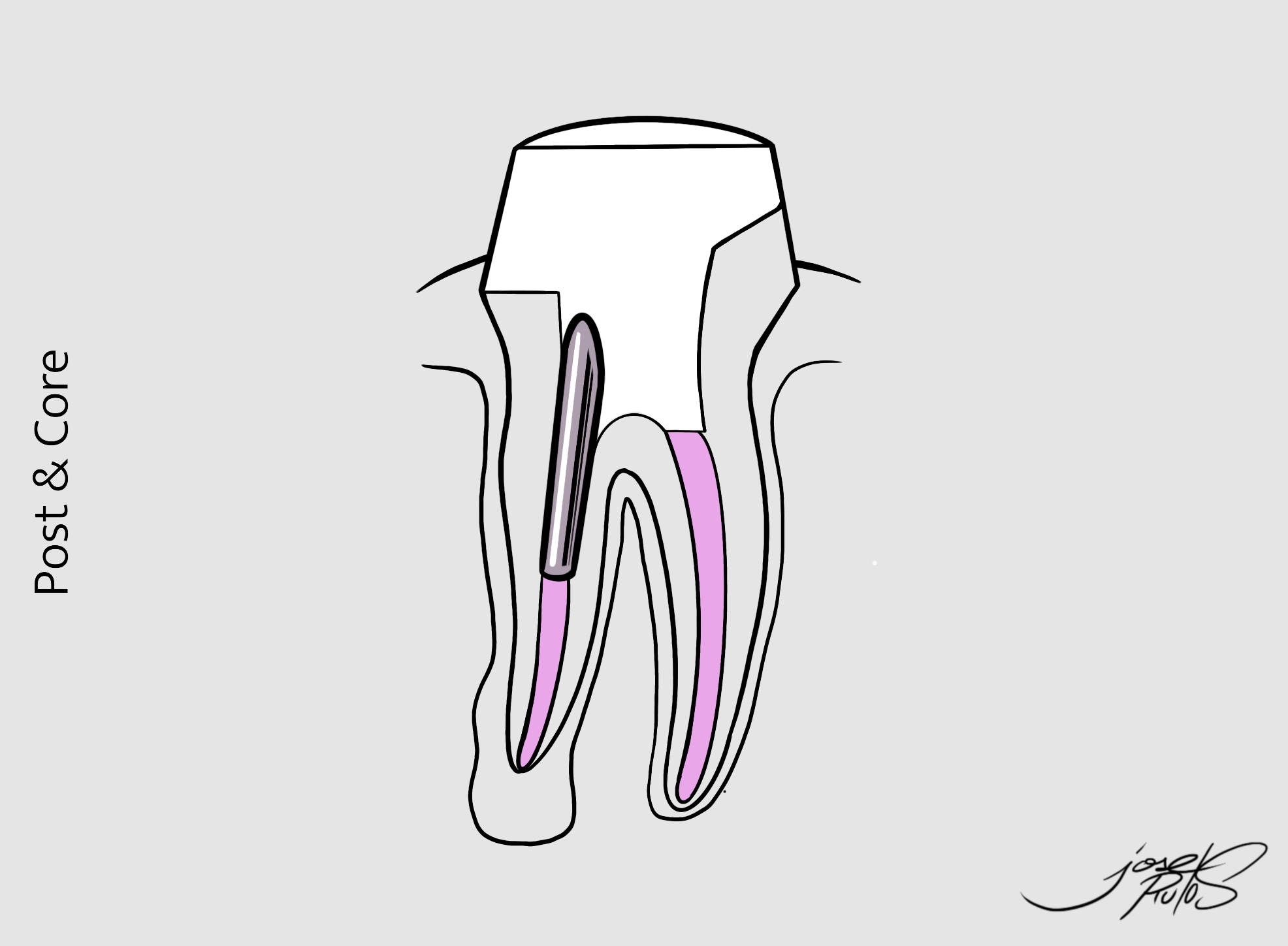

Root Canal Therapy–Or endodontic treatment
A root canal is needed when a cavity has reached the nerve–also called pulp–or is too close to it, to be able to do a filling or onlay successfully. It consists of removing the nerve and replacing it with a medication that stays inside the root for as long as the treatment is successful. A successful root canal is one where the paste fills to the tee the root but also must be dense enough not to allow bacteria to grow withing tiny existing voids. It is a technically challenging treatment, and even when it looks perfect on an x-ray, it often gets infected. What to do? Always try. If you can afford a specialist, it will be better. Because root canal can fail up to 50% of the time, there is a trend to extract teeth and place implants based on statistics, since implantology has a 95% success rate, in the right hands. I cannot emphasize enough that you should always try to save teeth. Implants will not last a lifetime unless….
Note that, more often than not, a tooth with endodontic treatment will need to have a Crown made due to the increased risk of fracture and will require a post-reconstruction sometimes built by the dentist, sometimes fabricated by the dental lab.
Temporaries
Temporaries are usually acrylic–resin- crowns, bridges or dentures, that are meant to be worn, yes, you guessed it temporarily, either while the Lab is making your final reconstruction, or while you are undergoing healing processes. If they are removable appliances, they should be worn as little as possible so that healing is undisturbed. When they are fixed, care should be given to the food you eat with them as they will easily break if you chew nuts or open beer bottles with them. They should be aesthetically and functionally acceptable even though they are temporaries. Yes, you should judge the professional by the temporaries you get. If they focus on making them beautiful, it shows how much attention they will pay to their final work. Don’t think that because it is temporary, it doesn’t matter. Wrong.
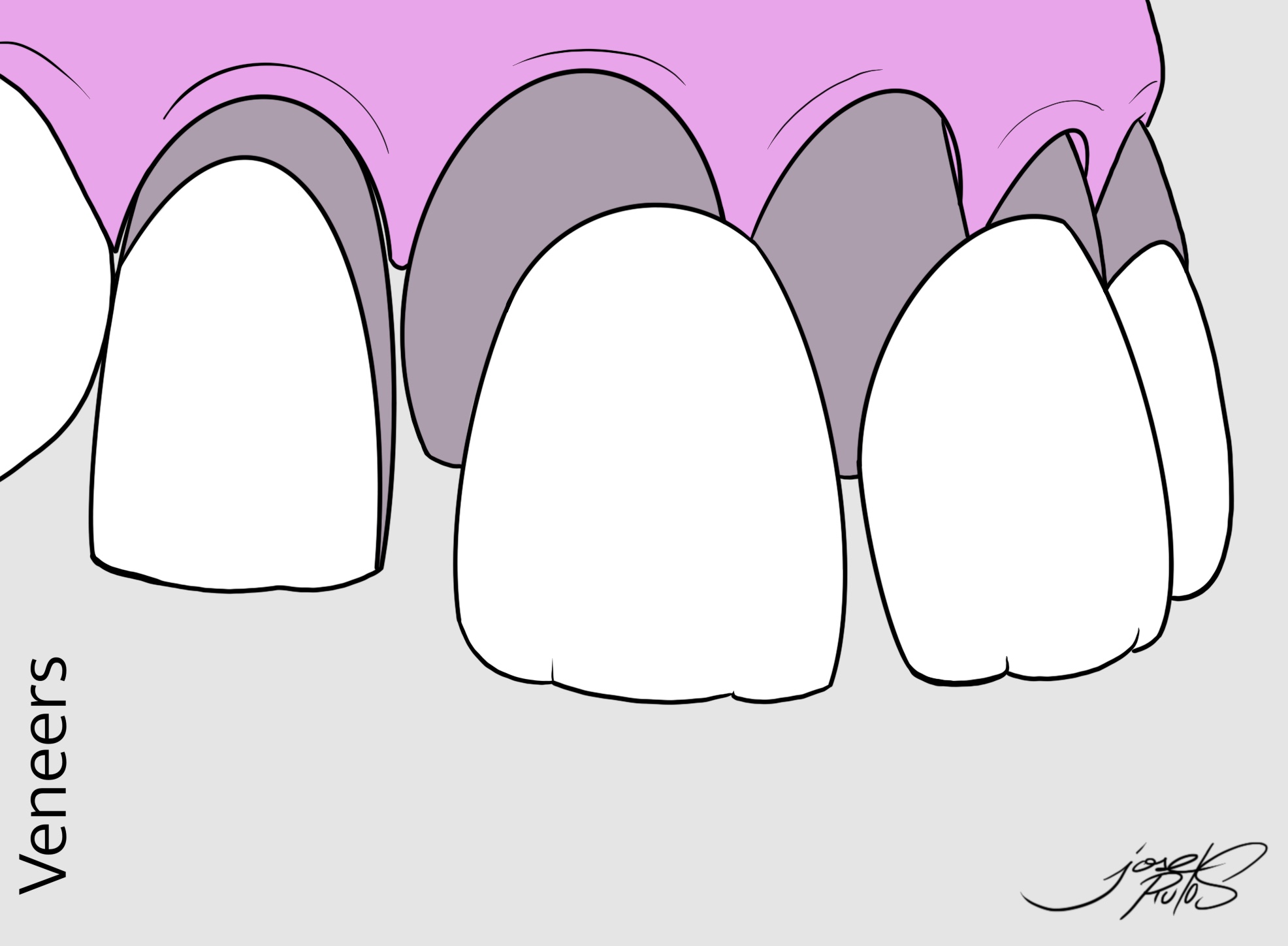
Veneers
Are thin laminates made of porcelain–most frequently and more beautiful–and placed on the surface of anterior teeth to correct defects in color, shape, or mild position. The dental Lab makes the veneers; therefore, it requires at least two appointments. The space occupied by the Veneer will have the equivalent enamel removed on your tooth to account for the thickness of the restoration, thus making it the right volume. While the Veneer is being made, you will have to wear a temporary that could sometimes be as temporary as the time it gets you to go back to your car. Oh well, as Buddhists say, all is impermanent.
In the right hands, Veneers are one of the most successful restorative treatments and much less invasive than crowns. Though you may end up needing a root canal because of the anatomy or the position of the tooth, the chances this will happen are lesser than with a crown. Also, even if you do, the risk of future fracture of the tooth is less because overall, we have removed less substance. Crowns are no-no’s if the problem is discoloration, shape, or small corrections in position, please.
Whitening
Against popular belief, having your teeth whitened by a professional does not damage them. What we do in a dental office is not comparable to anything you can buy off the shelf. We use concentrations and modified products that are much more efficient. We also use Ultraviolet light or laser to activate the product which enhances its whitening potential. If you want full-on efficiency, a professional whitening has always to be followed by at-home bleaching with custom-made trays for at least two weeks. The reason for this is that the slight reversible alteration of the enamel caused by the product we use in the office will remain for about fifteen days. Therefore, not only can you enhance the result, by using a whitening product for as long as the enamel pores remain open – it is a metaphor but close to reality -but you can also avoid immediate staining when the enamel is the most prone to it. It is also of utmost importance during those fifteen days, to prevent drinking colored carbonated sodas–which you should avoid anyway at all times since they also lower your PH. Stay away from any foods made with intense coloring agents, such as saffron, turmeric, or even cinnamon. No oranges, nor their juice, tea, or coffee, red wine, or any other colored drinks. If you have an addiction to any of them and do not want to give it up, brush your teeth right after drinking. Do not Smoke!
